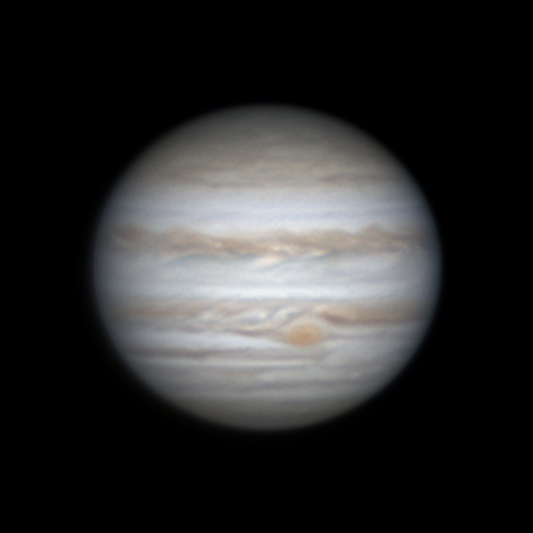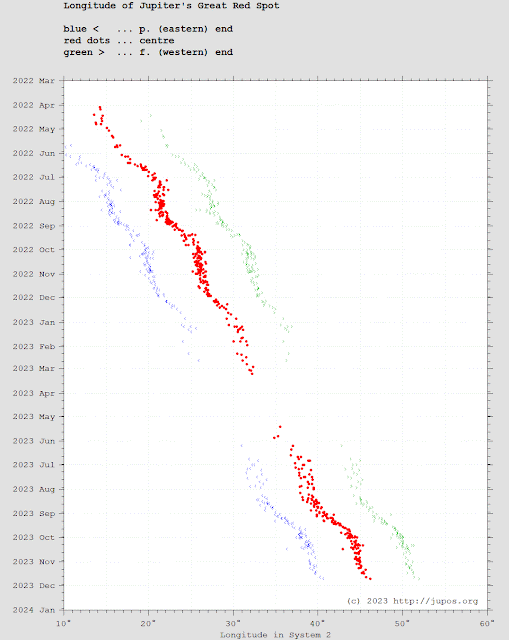Renowned amateur astronomer Christopher Go appealed to the OCA for images of Jupiter so I've been cranking them out and working on my technique.
 |
| Jupiter 11/26/23 05:53.3 UTC |
 |
| Jupiter 11/29/23 05:51.9 UTC |
 |
| Jupiter 12/6/23 07:10.6 UTC RGB "chimney open" |
Renowned amateur astronomer Christopher Go appealed to the OCA for images of Jupiter so I've been cranking them out and working on my technique.
 |
| Jupiter 11/26/23 05:53.3 UTC |
 |
| Jupiter 11/29/23 05:51.9 UTC |
 |
| Jupiter 12/6/23 07:10.6 UTC RGB "chimney open" |
Jupiter is the fastest rotating planet in our solar system, with a day lasting only 10 hours. thus Jupiter's Great Red Spot (aka small salmon spot) is only visible for a few hours each day. so if you see it one night, it will be visible 4 hours earlier or 6 hours later the next (multiples of 10 mod 24). this makes it tough to catch night over night. it's visible for about 2 hours and can be followed rotating across the face of the planet during that time.
 |
| Jupiter 11/22/23 05:22 UTC 2023-11-22-0522_5 CM1 60.8, CM2 59.9, CM3 102.6 |
a planetary frame of reference was created, roughly defined by the position of the great red spot. however, the great red spot's rate of movement across the surface varies with time, so it's position has to be intermittently updated relative to the planetary reference system.
the following is largely verbatim from references listed below:
Because Jupiter is not a solid body, its upper atmosphere undergoes differential rotation. The rotation of Jupiter's polar atmosphere is about 5 minutes longer than that of the equatorial atmosphere (wikipedia).
Three systems are used as frames of reference for tracking planetary rotation, particularly when graphing the motion of atmospheric features. System I applies to latitudes from 7° N to 7° S; its period is the planet's shortest, at 9h 50 m 30.0s. System II applies at latitudes north and south of these; its period is 9h 55 m 40.6s. System III was defined by radio astronomers and corresponds to the rotation of the planet's magnetosphere; its period 9 h 55 m 29.710s is Jupiter's official rotation (GJI).
"most (but not all) higher-latitude atmospheric disturbances including the Great Red Spot and the three white ovals move only slowly in system II." (GJI)
the Red Spot was at Jovian System II longitude 46° in November 2023 and continues to drift 1.75° per month, based on historical trends noted by JUPOS (sky and telescope)
note the planetary image above is annotated with 3 different central meridian (CM) positions, one for each system.
historical trends and recent observations are listed at JUPOS the organization associated with winjupos, a sophisticated planetary mapping program designed for advanced amateur astronomers to track planetary features. ironically the GRS position in the winjupos planetary surface texture is way off.
 |
| GRS longitude (Sy. 2) JUPOS database |
in the image above and my 11/12/2023 06:45.8 UTC image, i measured the GRS longitude at 46 in winjupos. sky safari lists it at 50, accounting for the difference in the image and planetarium software.
references:
https://en.wikipedia.org/wiki/Jupiter
https://skyandtelescope.org/observing/interactive-sky-watching-tools/transit-times-of-jupiters-great-red-spot/
Jupiter put on a nice show for west coast observers last weekend: Jupiter's moon Io and it's shadow transited the planet's surface just as the great red spot (GRS) was rotating into view.
 |
| Io and shadow transiting Jupiter's great red spot 11/12/2023 06:45.8 UTC CM1 331.7 CM2 46.6 CM3 86.7 CLat +3.8 Winjupos combination of 4x90 sec captures with independent processing of Io |
 |
| Io and shadow transiting Jupiter's great red spot 11/12/2023 06:35.7 UTC CM1 325.5 CM2 40.5 CM3 80.6 CLat +3.8 |
Animation of Io transit (larger version below):
 |
| Io and shadow transiting Jupiter's great red spot 11/12/2023 05:19-8:05 UTC |
 |
| Io and shadow transiting Jupiter's great red spot 11/12/2023 05:19-8:05 UTC |
 |
| Jupiter 11/1/2023 06:53 UTC little red spot just above center? |
You may recall that there was a supermoon in late september. the corollary to this is a "micro-moon" crossing the face of the sun during the solar eclipse at the subsequent new moon, resulting in an annular eclipse rather than a total eclipse 😢
or, to look on the "bright side" a super-annular eclipse with the widest band possible.
in creating a montage of the partial phases, i viewed the annular phase and decided on a clock-like arrangement with small images of partial phases forming a ring around the annular eclipse. after meticulously arranging the partial phases, i looked at what i had done...not exactly what i was going for, but i'll take it.
 |
| flower power! annular solar eclipse and preceding partial phases 10/14/23 balloon fiesta park, albuquerque, NM (click for full size) |
 |
| annular solar eclipse and preceding partial phases 10/14/23 balloon fiesta park, albuquerque, NM |
annularity animation:
 |
 |
| Annularity 10/14/23 Balloon Fiesta Field Albuquerque, NM |
if you look at the final images of annularity, you'll note that the moon does not contact the sun evenly. mountain peaks contact the sun first:
 |
| 3rd contact 10/14/23 |
by offsetting each image (captured at 4 frames per second) by 1 pixel, one can generate a magnified image of the lunar surface:
 |
| magnified moon mountains lower left Cf. APOD |
 |
| bigger partial phases click for full size |
the final 2 composites are a combination of the cell phone view of the field and nikon filtered images of the sun, scaled down to the sky view size and positioned roughly in the appropriate location in the sky
a few clouds and a lazy contrail on the horizon made for an interesting sunrise, but didn't impact the rest of the eclipse (click on image for full size):
 |
| sunrise balloon fiesta park abluquerque, NM 8/14/23 06:37:27 |
 |
| annular solar eclipse balloon fiesta park abluquerque, NM 10/14/23 ~10:36:32 |
 |
| 10:14:12 |
In planning the eclipse viewing site, I looked for 2 things: proximity to a major airport and a good probability of clear skies (see references below). I considered Albuquerque (so fun to spell) and learned the last weekend of the Balloon Fiesta, the largest hot air balloon event in the world, coincided with eclipse day. Boasting the most photographed event in the world, the fiesta hosts over 600 balloon teams. The overwhelming synchronicity made this the city of choice.
Note: some browsers require you to click on videos twice to play, click on images for full resolution, lower right icon will give video in full resolution.
The event started with a drone lightshow:
propane burners fueled the lighter-than-air crafts and lit up the fiesta:
 |
next came dawn patrol: a small group of balloons launch pre-dawn in order to test the winds at various altitudes for the rest of the pilots.
 |
 |
 |
| dawn patrol meets orion |
 |
| Balloon Fiesta, Albuquerque, NM 10/14/23 |
 |
 |
| impending balloonar occultation of venus |
special balloons:
 |
| the eyes on the ground belong to yoda who's apparently lost his flying skills |
 |
| semicircular shadows between fingers |
 |
| semicircular shadows between leaves |
 |
| Zia symbol heralds annular solar eclipse in New Mexico the land of enchantment |
 |
| New Mexico State Flag |
 |
| Partial solar eclipse 10/14/23 9:35 AM Local Albuquerque, NM |